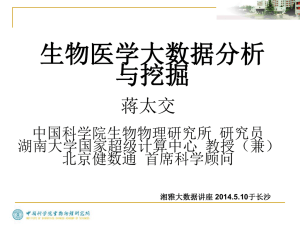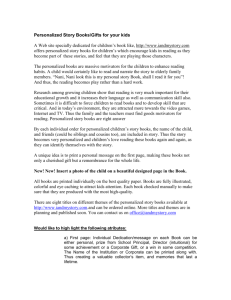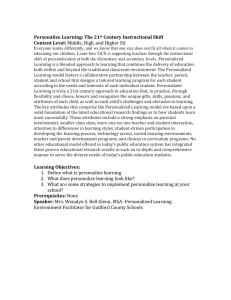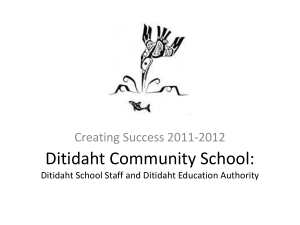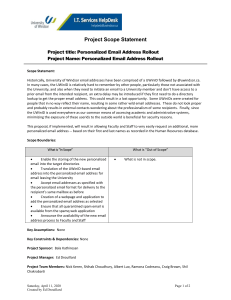Personalized human computation Please share
advertisement
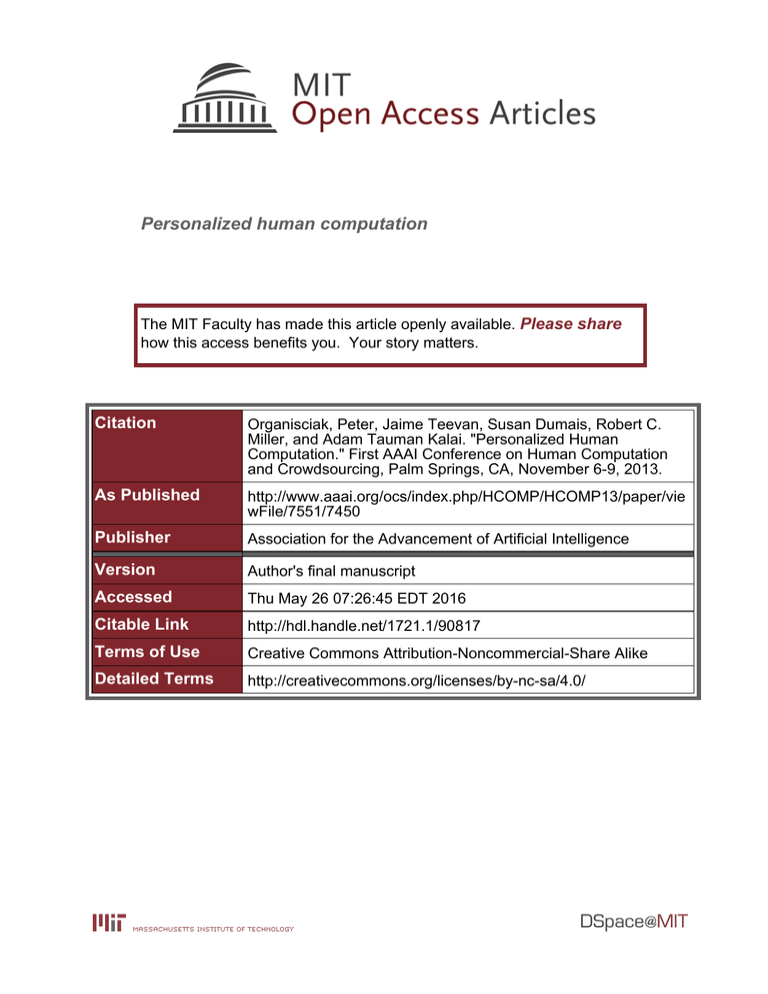
Personalized human computation
The MIT Faculty has made this article openly available. Please share
how this access benefits you. Your story matters.
Citation
Organisciak, Peter, Jaime Teevan, Susan Dumais, Robert C.
Miller, and Adam Tauman Kalai. "Personalized Human
Computation." First AAAI Conference on Human Computation
and Crowdsourcing, Palm Springs, CA, November 6-9, 2013.
As Published
http://www.aaai.org/ocs/index.php/HCOMP/HCOMP13/paper/vie
wFile/7551/7450
Publisher
Association for the Advancement of Artificial Intelligence
Version
Author's final manuscript
Accessed
Thu May 26 07:26:45 EDT 2016
Citable Link
http://hdl.handle.net/1721.1/90817
Terms of Use
Creative Commons Attribution-Noncommercial-Share Alike
Detailed Terms
http://creativecommons.org/licenses/by-nc-sa/4.0/
[THIS SPACE MUST BE
KEPT BLANK]
Personalized Human Computation
Peter Organisciak1, Jaime Teevan2, Susan Dumais2, Robert C. Miller3, Adam Tauman Kalai2
1University
2Microsoft Research
of Illinois at Urbana-Champaign
organis2@illinois.edu
{teevan, sdumais, adam.kalai}@microsoft.com
Abstract
Significant effort in machine learning and information
retrieval has been devoted to identifying personalized content
such as recommendations and search results. Personalized
human computation has the potential to go beyond existing
techniques like collaborative filtering to provide personalized
results on demand, over personal data, and for complex tasks.
This work-in-progress compares two approaches to personalized human computation. In both, users annotate a small set
of training examples which are then used by the crowd to
annotate unseen items. In the first approach, which we call
taste-matching, crowd members are asked to annotate the
same set of training examples, and the ratings of similar users
on other items are then used to infer personalized ratings. In
the second approach, taste-grokking, the crowd is presented
with the training examples and asked to use them predict the
ratings of the target user on other items.
Introduction
We are studying how to complete non-normative tasks in
crowdsourcing environments. Most research thus far in
human computation has focused on how to generate consensus among disparate workers. Our goal is to understand how
to collect results from online crowds when the standard of
quality is based upon the individual tastes of a particular
user rather than an objective truth. We present an initial
comparison of two protocols for collecting personalized
crowdsourcing results, taste-matching and taste-grokking.
Motivation and Related Work
Personalized search and recommender systems employ collaborative filtering algorithms and other techniques to generate personalized results based on prior data from humans
and other sources. For example, movie selection behavior
may be passively observed across many users and then used
to recommend particular movies to individuals based on the
behavior of related users. Our work builds on related literature in active collaborative filtering (e.g., Mahltz and
Copyright © 2013, Association for the Advancement of Artificial
Intelligence (www.aaai.org). All rights reserved.
3Massachusetts
Institute of Technology
rcm@mit.edu
Ehrlich, 1995) to explore how the crowd can be used to
generate personalized results.
Rather than relying on users to passively provide
annotations for personalization, we propose using crowd
workers to actively collect these annotations on demand. A
paid crowd can be employed at a moment’s notice
(Bernstein et al, 2011) to address the cold-start problems on
previously unannotated sets of objects. This means that
annotations can be collected over new types of data sets,
such as personal photo collections. Additionally, because
human intelligence is involved in the process,
personalization can be embedded in complex creative tasks.
Many existing crowdsourcing tasks address personalization to the extent that they try to address an individual’s
specific needs. For example, Mobi (Zhang et al, 2012)
provides crowdsourced itinerary planning in response to a
short textual description of a trip. Likewise, selecting the
“best” frame to represent a video (Bernstein et al, 2011) has
an element of taste.
In existing systems, for the crowd to meet a user’s need
the user must state their desired outcome explicitly, which
can be challenging to do well. Research in personalization
has found that examples of a user’s need can often implicitly
communicate the desired outcome better than an explicit
description (Teevan et al. 2010). For example, when
considering the photos a person likes, someone who highly
rates photos that are slightly blurry implicitly conveys that
focus is not a crucial feature. It is unlikely, however, that the
user would think to actively describe their photo preferences
by saying, “I don’t mind photos that are a little blurry.”
Randomly choose training set 𝑆 ⊂ 𝑋 of examples
Target user 𝑡 rates each object in 𝑆
Workers 𝑤 ∈ 𝑊 provide their own feedback on 𝑆
Workers are filtered based on taste similarity to target 𝑡
For each subsequent task, workers 𝑤 ∈ 𝑊 provide
feedback of their own tastes on remaining data 𝑋 ∖ 𝑆
Figure 1: Taste-matching Protocol
Randomly choose training set 𝑆 ⊂ 𝑋 of examples
Target user 𝑡 rates each object in 𝑆
Examples in 𝑆 and their ratings presented to the crowd
Workers 𝑤 ∈ 𝑊 predict 𝑡’s ratings on 𝑋 ∖ 𝑆
Results are aggregated to project ratings
Figure 2: Taste-grokking protocol
Approach
We explore two different ways to personalize human
computation. In the first, which we call taste-matching,
workers who are subjectively similar to the requester are
identified and asked to provide annotations. This approach
functions like collaborative filtering: people with similar
opinions in a domain can be expected to align on unknown
or future opinions. In the second, which we call tastegrokking, workers are provided with examples of the
requester’s taste and asked to infer how the requester might
annotate other items. Workers are not required to be similar
to predict the subjective tastes of a requester, as a human
worker with very different tastes may still be able to infer
the requester’s needs if sufficiently well communicated.
For simplicity, we assume that the goal is to provide
personalized projected ratings on a given rating scale of a
large set 𝑋 of objects. However, although the protocols are
described for rating, similar ideas may be used in more complex human computation protocols.
The taste-matching protocol (Figure 1) profiles requesters
by asking them to annotate a number of training examples.
Workers are profiled using the same examples. Similarity
between the worker profiles and the requesters’ is then
calculated, allowing us to determine which workers are the
most appropriate personalized workers for the requester.
The number of training examples is dependent on the task.
The taste-grokking protocol (Figure 2) converts the task
into one with a presumed ground truth, allowing us to use
existing reliability metrics. For example, a held-out set of
training examples may be used to evaluate worker quality.
Preliminary Experiments
We explored taste-matching and taste-grokking using
Mechanical Turk to annotate 100 images of salt & pepper
shakers from Amazon.com. Thirty workers rated the 100
images on a scale of 1-5 stars. Then, by using a subset of the
ratings from one worker as a “requester”, we evaluated the
Baseline
Taste-matching
Taste-grokking
1.59
1.10
1.07
Table 1: RMSE of target user predictions
performance of our two different approaches in predicting
that requesters other ratings.
To develop a baseline, we selected ten random examples
for training, and used the remaining 90 for testing. We then
calculated the average root-mean-squared error (RMSE) of
predictions over the test examples for each worker in the
pool as a predictor of each other worker. For taste-matching,
the top quartile of users on the training set were used as the
well-matched worker. Their ratings were used to predict on
the test examples for each user in the pool. For tastegrokking, ten workers were chosen, shown the target’s
ratings on the ten examples and their predictions were
averaged on each of the 90 test examples.
The results from these experiments are shown in Table 1.
Both personalized approaches improved in quality over a
baseline where neither was applied. For these results, tastegrokking with predictions from an aggregation of multiple
workers appears to work slightly better with less variance,
and we hope to see if this holds true across different tasks.
While workers reported enjoying both tasks, preliminary
feedback suggests that the taste-grokking was generally
more enjoyable. Early work suggests that there is an effect
based upon which examples are used to teach the taste.
Next Steps
By examining taste-matching and taste-grokking across
multiple domains, we aim to see if one approach
outperforms the other in general, or if different approaches
are optimal for different domains. We also plan to apply
taste-matching and taste-grokking to more complex and creative tasks. Finally, we are exploring various parameters that
affect the protocols in different contexts, such as the optimizing the choice of training examples, choosing sample
sizes, and balancing cost and quality improvements.
References
Bernstein, M. S.; Brandt, J.; Miller, R. C.; and Karger, D.R. 2011.
Crowds in two seconds: enabling realtime crowd-powered interfaces. In Proceedings of UIST 2011, 33-42.
Maltz, D.; and Ehrlich, K. 1995. Pointing the way: active collaborative filtering. In Proceedings of CHI 1995, 202-209.
Teevan, J.; Dumais, S.T.; and Horvitz, E. 2010. Potential for
personalization. TOCHI, 17(1).
Zhang, H.; Law, E; Miller, R.C; Gajos, K.; Parkes, D.; and Horvitz,
E. 2012. Human computation tasks with global constraints. In Proceedings of CHI 2012, 217-226.
![[THIS SPACE MUST BE KEPT BLANK] Personalized Human Computation](http://s2.studylib.net/store/data/013847975_1-ccb32ccd21576e389c7aa873d0a89284-300x300.png)



